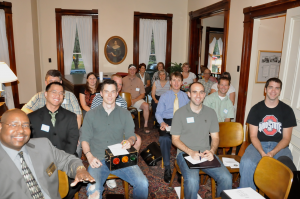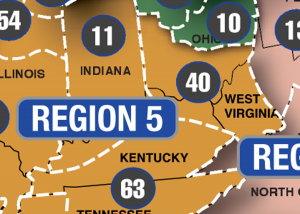When I was Lieutenant Governor of Education, I heard of a nearby Toastmasters club that was in need of help. The Moundbuilders Club was chartered as an open club in June of 1947. Over the years the club experienced many rough peak and valleys as every club does. I began visiting the club and continued to visit the club for three months to observe the club and make the members comfortable.
The club’s atmosphere when I began was as follows: few people attended a meeting, those who did attend arrived late causing the club to begin at 6:45 rather than 6:30 P.M. Other members simply walked in whenever they could, there was no agenda, the members didn’t know the meeting roles in advance, and there was little organization. The club survived on the efforts of a handful of dedicated people. They did their best, but they didn’t know what a good meeting looked like. They didn’t see the big picture, nor understand the overall potential and value of a properly organized and run meeting.
After a while, I asked them if they’d like a club coach. They replied, “What’s that?” The club didn’t know what a coach or that even a better Toastmaster way even existed because they were used to their current situation. It was their status quo – they felt like their situation was normal.
In preparation for the coaching appointment, I read How to Rebuild a Toastmasters Club from cover to cover. I also refreshed my memory of the Distinguished Club Program by reading that module from the Successful Club Series.
My Approach
My approach to club coaching was to do the right thing, to be helpful, and to treat others as you want to be treated. I had already chartered several clubs, and subsequently earned my Distinguished Toastmaster Award. This coaching experience was not to be for credit, it was simply a matter of seeing a struggling club and having the knowledge to help them. To make my philosophical approach a reality, I focused on three actions. I would …
1) Create opportunities for discussion.
2) Ask questions to facilitate improvements.
3) Teach through demonstration, then transfer responsibility to the members.
Together, We Improve the Club
The first thing I did was join the club. This cemented by relationship with the club and gave an immediate demonstration of my commitment. Next, I encouraged the officers to schedule an officer meeting. This would create an opportunity for discussion and increase the number of helpers from just the coach, to the coach and the officers. Once the first meeting occurred, I attended. To facilitate the proper function of the officers meetings, I provided a template agenda. The first officer meeting was very important. I was given a few minutes to facilitate a discussion that would later lead to improvements. I asked them why did they come to Toastmasters? I explained why I came and in my answer, I gave an understanding of the whole picture. In other words, I gave them the concept of Toastmasters. I can remember the faces of the officers and I can still see the ideas appearing in their heads, just like little light bulbs.
In this officer meeting and in subsequent ones, I led the officers in question and answer sessions. I asked them what do we need to do to grow? Where can we look for members? When they had an idea, I asked them is that something you want to do? This interactive process created some well- discussed and developed ideas. It also generated a lot of enthusiasm. But before we built upon the enthusiasm, I asked them first to create a quality product. We needed a quality product (meeting) before the prospective customers (guests) arrived.
To show the club a quality Toastmaster meeting, we planned a great meeting for the members. Their agenda required 11 people to complete their roster. We planned to fill the agenda with members first, then invited guests from other Toastmaster clubs. This staffing of meeting roles to create a full agenda really energized them. For once, they didn’t have to do two roles. It was relatively easy to recruit Toastmasters from other clubs a simple email brought several experienced Toastmasters who helped us. At our second meeting, we repeated the process and this time, invited non-Toastmaster guests. In short, we prepared our club for guests, then we invited them.
Throughout the early stages of the coaching process, I helped the club prepare for the proper treatment of guests with a few pieces of advice and through demonstrations. I told them about a guest book, but with limited funds $USD 40 we used a sign-up sheet instead. I shared with them all the free stuff available from Toastmasters International. I offered my advice about how to prepare a guest packet. It was a simple paper folder with a sticker on the front page saying, “Welcome Guest!” On the left side of the folder, was a brochure stating the benefits of Toastmasters. On the right side of the folder, was a letter from the President or VPM thanking the guest for attending, a history of the club and some contact information. Behind it, a brochure such as Confidence: The Voice of Leadership or Find Your Voice. The last item was a membership application. The overall concept was simple: welcome, consider joining us. I’ve seen some guest packets that overload the guest and some clubs offer nothing at all. My advice was to create something appropriate.
Besides the guest packet, I taught the club to welcome guests. Every member, not just the VPM or President, needs to greet guests. I taught the members how to sign up a guest as a member. In the beginning, everyone brought guests to me. I explained to the guest how Toastmasters can help people meet their goals. Then we had a transition from me as the go-to person to club members. I led the effort, but the club continued it.
Like everything I did, I handled things to the club gradually. Another example is a contest held at the club level in the fall of that year. My wife, also a member of the club, served as the Contest Chair. While I served as the contest TMOD. I ordered the materials and we demonstrated a great contest. In the spring, the members of the club organized and conducted the contest. The members gained the knowledge by watching, then doing.
 The club added 22 members that year. Because of the huge influx of members, we needed a program to educate the newer Toastmasters. To orient the members, I created a orientation program entitled Toastmasters 101 and 102. The program was comprised of modules from the Better Speaker Series such as how to write an introduction, opening, concluding your speech, taking the terror out of the talk. To continue the strategy of having the members learn by doing, I asked members of the club to study and present the modules. They were awarded certificates or documents to record the event. The members had to learn about the material because they had to present the material. These events were so popular it was standing room only.
The club added 22 members that year. Because of the huge influx of members, we needed a program to educate the newer Toastmasters. To orient the members, I created a orientation program entitled Toastmasters 101 and 102. The program was comprised of modules from the Better Speaker Series such as how to write an introduction, opening, concluding your speech, taking the terror out of the talk. To continue the strategy of having the members learn by doing, I asked members of the club to study and present the modules. They were awarded certificates or documents to record the event. The members had to learn about the material because they had to present the material. These events were so popular it was standing room only.
To review my approach, I shared in the officer meetings and I encouraged discussions among the officers. I showed the members how they could participate and gave them a foundation for how a club is supposed to be run. The club became stronger. Most importantly, they learned how to be a healthy, well-run club.
Lessons Learned
The coach must be a teacher and a leader. Underlying this, the coach must have an altruistic purpose and attitude. Everything is easier when the coach has a relationship with the club. I build my relationship with the members through discussions and by demonstrating the proper actions of a Toastmaster. Besides a relationship, there needs to be a good fit. To fit with the club, I became a member. Using my background and experience with several clubs and years of service as a district leader, I was able to show them the big picture. This increased participation and led to our success.
By: W.D. Smith, Jr. Coach of the Moundbuilders #511 District 40
